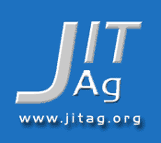Review Procedures
Editorial Review
JITAg employs a two-tiered review system. That is, the editor first reviews each submission to determine whether or not it is suitable to be sent out to the peer reviewers on the JITAg Manuscript Review Committee.
If the submission is not suitable for review, the editor either rejects the submission or returns the submission to the author with (often substantive) revision suggestions.
Peer Reviewers
The Journal of Information Technology in Agriculture (JITAg) is a peer-reviewed publication. A Manuscript Review committee composed of agricultural IT professionals with backgrounds in a variety of subject areas and from different parts of the world serve on the committee. Reviewers are appointed for two-year terms by the editor, with the approval from the JITAg's Board of Directors. A list of current Manuscript Review Committee members can be found in each issue of JITAg . Instructions for retrieving that listing are given in each issue's Table of Contents.
Peer Review Process
JITAg uses a blind review process. That is, all references to the author(s) are removed before the manuscript is sent out to reviewers.
A set of criteria is used by reviewers to evaluate manuscripts submitted to the JITAg . Reviewers are asked to assign a numerical rating from 1 (weak) to 10 (strong) for each criterion and provide comments on a rating sheet and/or on the manuscript itself. This process is handled through e-mail.
Feature and Research in Brief manuscripts are reviewed by three committee members. Ideas at Work manuscripts are reviewed by one committee member. Tools of the Trade and Commentary manuscripts are reviewed by the editor.
Reviewers are asked to make a disposition on each manuscript they review and submit it to the editor. They can recommend:
Publish manuscriptPublish with minor revisions
Publish with major revisions
Use ideas and start over
Reject manuscript
The editor weighs the reviewers' comments and recommended disposition for each manuscript in making the final publication decision. When authors are asked to revise and resubmit manuscripts, the revision may be sent for another round of reviews by the Manuscript Review Committee members or reviewed by the editor. That decision is made at the discretion of the editor.
The two tiers in the JITAg review system add up to a unique combination of academic rigor and professional development. JITAg both "keeps the bar high" and helps authors get published.
Criteria for Evaluation
Criteria vary somewhat depending upon the review category (Feature, Research in Brief, etc.). The criteria for each category are listed below.
Feature Article
Content Criteria
____________________________________________
Contribution: Expands or updates agricultural ITresearch and knowledge
base. Important enough to give space in JITAg.
Audience: Of broad interest to agricultural IT professionals
in general.
Usefulness: Helps Extension educators improve their effectiveness. Specifically suggests applications.
Rigor: Based on valid and reliable information, documentation or sound concepts; content is empirically, logically and/or theoretically supported.
Clear Focus: Central ideas, findings and conclusions control the article. Has a clear main point.
_____________________________________________
Readability Criteria
_____________________________________________
Interest: Captures and holds readers' attention.
Understandable: Uses easy-to-understand language and flows smoothly.
Development: Appropriately sequences and constructs paragraphs and sentences to support the central idea and conclusions.
Mechanics: Uses acceptable standards of spelling and grammar.
______________________________________________
Research in Brief
Content Criteria
______________________________________________
Audience: Of interest to agricultural IT professionals.
Importance: Important enough to give space in JITAg . Research uses
unique methods and/or produces interesting or unusual findings.
Methods: Offers a clear statement of the research problem and methods used.
Rigor: Based on valid and reliable information, documentation or sound concepts; content is empirically, logically and/or theoretically supported.
Findings: Describes the research findings with emphasis on their implications.
Usefulness: Indicates the usefulness of the methods or findings to Extension educators.
_____________________________________________
Readability Criteria
_____________________________________________
Interest: Captures and holds readers' attention.
Understandable: Uses easy-to-understand language and flows smoothly.
Development: Appropriately sequences and constructs paragraphs and sentences to support the central idea and conclusions.
Mechanics: Uses acceptable standards of spelling and grammar.
______________________________________________
Ideas at Work
Content Criteria
_____________________________________________
Importance: Important enough to give space in JITAg . Something
that Extension professionals need to know or would want to know.
Innovative: Describes something not already widely known or done.
New enough to be considered innovative in some way.
Audience: Of interest to Extension educators involved in programming.
Usefulness: Provides suggestions for practical applications.
Repeatability: Provides information or resources so that program or idea can be repeated or adapted.
Clear Focus: Clearly describes one idea.
______________________________________________
Readability Criteria
______________________________________________
Interest: Captures and holds readers' attention.
Understandable: Uses easy-to-understand language and flows smoothly.
Development: Appropriately sequences and constructs paragraphs and sentences to support the central idea and conclusions.
Mechanics: Uses acceptable standards of spelling and grammar.
______________________________________________
Tools of the Trade
Tools of the Trade articles report on specific techniques, materials, books and technology that can be useful to agricultural IT professionals. They are reviewed by the editor for appropriateness and relevance for the Journal of Information Technology in Agriculture, and for readability according to the criteria applied to other articles.
Commentary
Commentary articles state an opinion, offer a challenge, or present a thought-provoking idea on an issue of concern to Extension, including a published article in JITAg . They are reviewed by the editor for appropriateness and relevance for the Journal of Information Technology in Agriculture, and for readability according to the criteria applied to other articles.
Submission Procedures
Review Procedures
Help for JITAg Authors
Q&A for Authors

